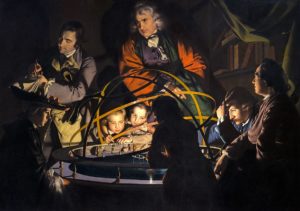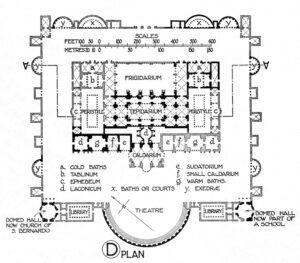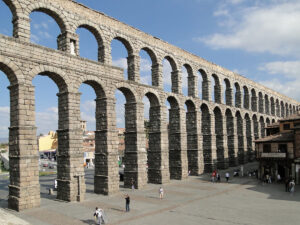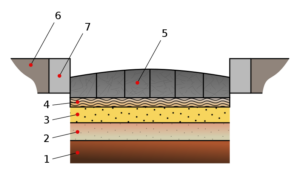 Another major feature of Roman cities were the baths, more or less a Roman version of the Greek gumnasion.
Another major feature of Roman cities were the baths, more or less a Roman version of the Greek gumnasion.
Roman baths were fairly similar to modern health clubs. Upon entering you’d go to a locker room of sorts, then to an exercise area (boxing, discus throwing, weight lifting, wrestling) or to a swimming pool, or to a series of warm and hot rooms, perhaps to a steam room, and then to a cold bath.
After that (including washing with soap in the later centuries), you might get a massage with oils, after which the oil would be carefully scraped off, rather like a skin treatment.
After that, you might visit the bath’s shops for something to eat, or to buy a variety of other things such as perfumes. Bath complexes also had libraries and reading rooms. They might host athletic competitions or musical performances. And because both wealthy and poor Romans went to the baths (the entry fee was very low), it was a primary place to sit and talk to those in higher or lower ranks than yourself, and hopefully to form relationships with them.
Baths usually had separate men’s and women’s sections. They generally opened around lunchtime and remained open until dusk. The largest baths were built by emperors, while smaller, neighborhood baths (of which there were very many) were private businesses.
Below is the plan of the baths of the emperor Diocletian. Please note the scale to grasp the size of these complexes.

Roman cities were shockingly modern. They were full of taverns, snack shops, public toilets, apartment houses, workshops, meat markets, bakeries, hotels and all sorts of stores. They also had innumerable musical performances and hosted major sporting events like chariot races. The stadiums for these events rivaled our own in some cases. The Circus Maximus in Rome seated at least 150,000 people. And, as strange as it sounds, some of these stadiums were equipped with pipe organs.
Here is a photo of a fast-food restaurant that was unearthed fairly recently. In just a medium-sized city (Pompeii) there were more than 100 such restaurants.

What really made the Roman cities work were their engineering projects, especially aqueducts and roads.
Aqueducts (a large, above-ground section of one is pictured below) brought water to the cities from distant springs, rivers or other clean water sources. Rome alone received some 300,000,000 gallons daily. These aqueducts were so well-made that a few small sections remain in use. (Rome also had a very extensive sewer system.)

Roman roads were extremely well-made; quite a few, in fact, still exist. They were built for military use, but also for commerce. And there were very many of them. There were at least 13,000 miles of roads in what is now France, for example.
Here’s a cross-sectional drawing of a Roman road:

Layer 1 was compacted soil.
Layer 2 was composed of larger stones, a few inches in diameter.
Layer 3 was rubble, concrete, broken stones and/or lime, depending upon available materials
Layer 4 was a bedding of fine cement.
Layer 5 was a crown made of durable stone, designed to shed water like the shell of a tortoise.
Numbers 6 and 7 were, respectively, the sidewalk and curb.
But more than the paving itself, Roman roads were part of a much larger system. There were, for example, mile-markers on every road, showing travelers precisely how far it was to the next city. There were also way stations every fifteen miles or so, where you could change your horses, repair your wagons, and so on. These were the truck stops of that time.
Public stagecoaches ran regularly over the Roman roads, averaging 60 miles per day. The Roman postal providers carried mail 100 miles per day (by carriage or horse, traveling both day and night) over these roads.
The thousands of workers who built and maintained these systems (aqueducts and roads) were the true heroes of urban Rome. Without them such cities could not have existed.
Travel by sea was also available and affordable. Passage from Alexandria to Athens, for example (a significant voyage), cost roughly $23.00 in today’s money. But you would have to bring your own food and sleep on the deck.
Check out our back issues. I promise you they are unique.
